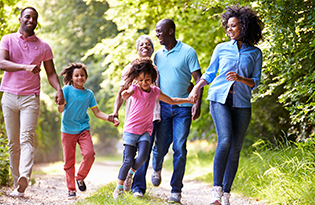Family movement matters
12/28/2020 by Angela Hazelton

Choosing a healthy lifestyle is a great way to strengthen the immune system. This includes regular exercise, as it helps promote good circulation, allowing immune system particles to move through the body more freely and work more efficiently. A bonus is that physical activity is well-known for its mood-boosting abilities, too. Incorporate your family members to bond and share smiles throughout the day.
Babies
It is well-known that a great deal is learned through mirroring the actions of others. Mirroring the actions of your child is also a wonderful way to create and enhance social bonds in a fun and playful manner. While creating a stronger social connection with your little one, you may be surprised as to how much you learn about your own body in the process.
Actions like rocking, rolling and crawling help develop foundational qualities to more complex interactions. Your body reacts simultaneously while interpreting information from the ground and other objects. Help your baby create the foundational stability while you readdress the proper sequencing your body may have forgotten.
The body was designed to accommodate a wide range of positions. Unfortunately, adults typically do not participate in a variety of movement patterns. Simple movements such as rocking, rolling and crawling are effective ways to enhance or maintain a flexible body.
Toddlers and grade schoolers
If your littles are beyond floor play, put a twist on your family walk and go for a bear hunt in your neighborhood. People from all over the world are participating in this physical distancing scavenger hunt. Teddy bears are placed in windows or other perches around the house. Hearts also are being displayed to support and spread happiness. Then children and their families go for walks or bike rides to spot as many as they can.
If you have a swing set in your backyard, you can get your strength on while your children are out playing. Complete some suspended rows by holding on to the swing's chains, plant your heels into the ground and drive your elbows back. While keeping your body in a straight line from head to heel, extend your arms straight in a controlled fashion. Then breathe out while bending the elbows and driving them back again. You've just completed your first suspended row.

Assisted squats can be great using a swing, too. Hold on to the swing's chains, have your feet hip distance apart, and then bend your hips and knees as though you were going to sit in a chair. Use your arms while holding onto the swing for additional support and balance as you return to stand.

Tweens to teens
If you're seeking to up the ante and competition with your tween and teenagers, get creative and set up an indoor or outdoor obstacle course. Obstacles can include physical abilities, such as crab-walking, three-legged races, hopscotch and hula hooping. Brain games can be a fun way to work on educational materials, too. On a piece of paper, put some long division equations that need to be answered correctly before moving on to the next obstacle. Get creative with adding in some science: such as listing the planets in order, starting from closest to the sun or asking younger children if they think specific items will sink or float. Have your child select the correct spelling from a spelling list. You get the idea.
If you're not naturally competitive, get outdoors and toss or kick a ball around. Many fitness professionals are posting free workout videos online. Find one that you all can complete together, and play some active video games.
Whatever option is the most appealing, it's getting up and moving as a family that is important. Being a role model for healthy behaviors can lead to positive choices and behaviors in your kiddos who look up to you.
Angela Hazelton is a wellness activities and assessment specialist at the Mayo Clinic Healthy Living Program at Mayo Clinic in Rochester. She is skilled in exercise design for a wide variety of populations in the preventive and rehabilitative settings. She has a passion for working with prenatal and postnatal women, people with cardiovascular concerns, and kettlebell enthusiasts.
